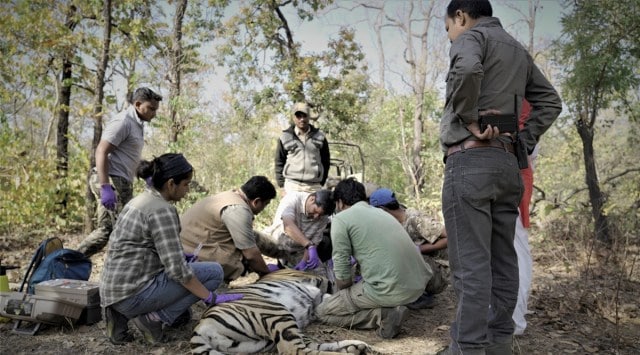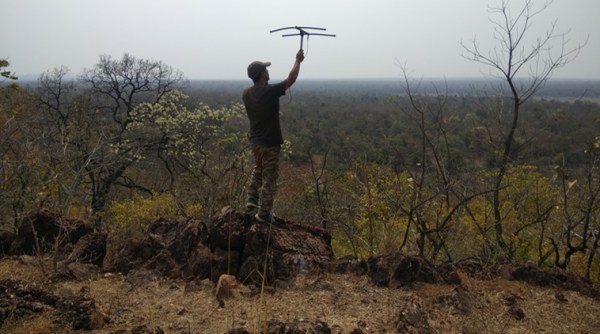- India
- International
Study maps Vidarbha tiger corridors; movement far beyond guarded areas
Vidarbha has 331 tigers in a forest area of around 26,775 sq km, dissected by 84,202 km of roads, apart from irrigation canals and other projects. There have been growing instances of man-tiger conflict in the region.
 Forest department officials put a radio collar on a tiger. (Photo: Forest department)
Forest department officials put a radio collar on a tiger. (Photo: Forest department)In a first-of-its-kind project, radio telemetry has been deployed to identify corridors used by tigers in the Vidarbha landscape, tracking their actual movement — indicating that the animals are moving in a much wider swathe of area outside the protected areas than previously known.
Vidarbha has 331 tigers in a forest area of around 26,775 sq km, dissected by 84,202 km of roads, apart from irrigation canals and other projects. There have been growing instances of man-tiger conflict in the region.
The project, carried out between 2017 and 2020 using radio signals, identified 37,067 sq km, in all, of tiger corridors, further categorised into five classes as per frequency of tiger use — namely very low (10,289 sq km), low (18,727 sq km), medium (5,689 sq km), high (1,418 sq km) and very high (942 sq km).
The investigators, belonging to the Maharashtra Forest Department and Wildlife Institute of India (WII), principally tracked dispersal of 15 sub-adult tigers, including seven females, to identify the corridors. Five of them, which included four females, were from outside the protected areas.

Their report says, “It (the tiger movement) extends well beyond forested structural corridors modelled by earlier studies. The study shows extensive use of agricultural land by tigers adjoining small fragmented forests and rivers. Tigers in these landscapes were seen pushing the boundaries of human tolerance, ready to accept the risks of exploring a human-dominated landscape.”

Senior WII scientist Bilal Habib, who was part of the study along with colleague Parag Nigam, says, “We have for the first time mapped actual corridors in the Vidarbha landscape. We now know how and where the tigers move. For example we tracked the epic journey of Walker (as the tiger was dubbed) over 3,000 km from Tipeshwar Sanctuary in Yavatmal district to Dnyanganga Sanctuary in Buldhana district. The study should help wildlife managers focus exactly where they need to in order to not only provide safe passage to the dispersing tigers but also mitigate the serious man-tiger conflict in Vidarbha.”
 Forest department officials during the project. (Photo: Forest department)
Forest department officials during the project. (Photo: Forest department)
The report notes, “The importance of tiger connectivity for wild animals in fragmented landscapes is increasingly being used as a strategy to mitigate the effects of habitat fragmentation, land use dynamic and climate change. However, movement data are yet to be systematically incorporated into assessments and prioritisation of connectivity. This study uses movement data to quantify habitat use outside PAs (protected areas) and incorporate the same into connectivity modelling.”
The report adds that a successful conservation effort should include an array of stakeholders, rather than be seen as just the jurisdiction of the forest management. “The local people, the district administration, local NGOs and various developmental agencies should now work in tandem with the forest management. The findings of this report may provide clues to managers so as to target proactive and pre-emptive management interventions for conflict prevention/mitigation and connectivity conservation.”
The co-authors of the study include Principal Chief Conservator of Forests (Wildlife) Nitin Kakodkar, WII Director Dhananjai Mohan, National Tiger Conservation Authority Member Secretary S P Yadav and Additional PCCF (Wildlife) B S Hooda.
Apr 27: Latest News
- 01
- 02
- 03
- 04
- 05








































